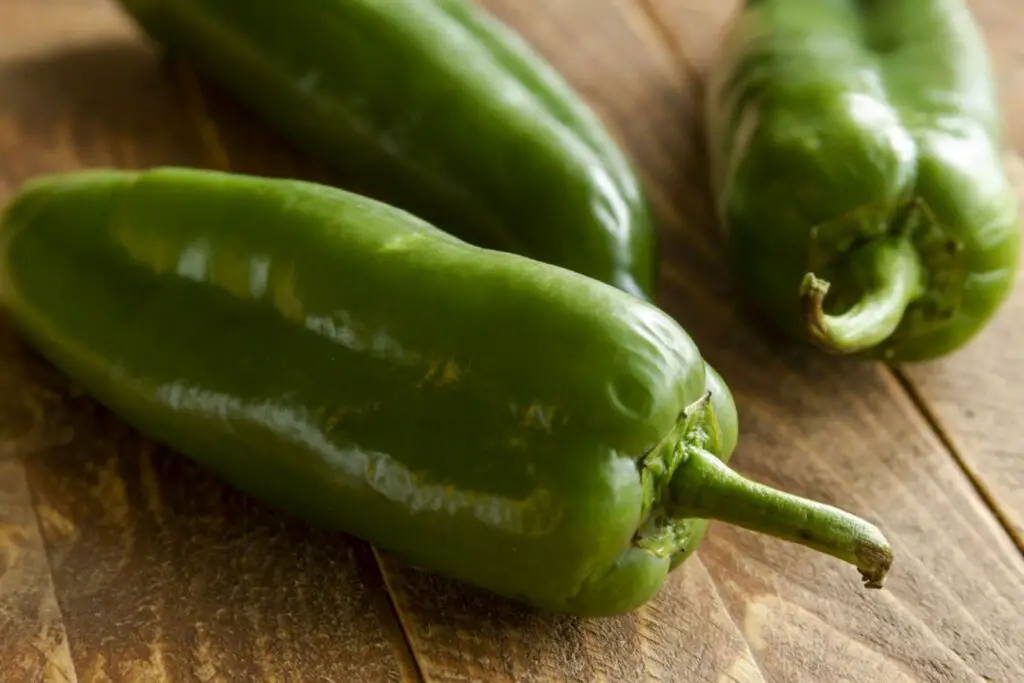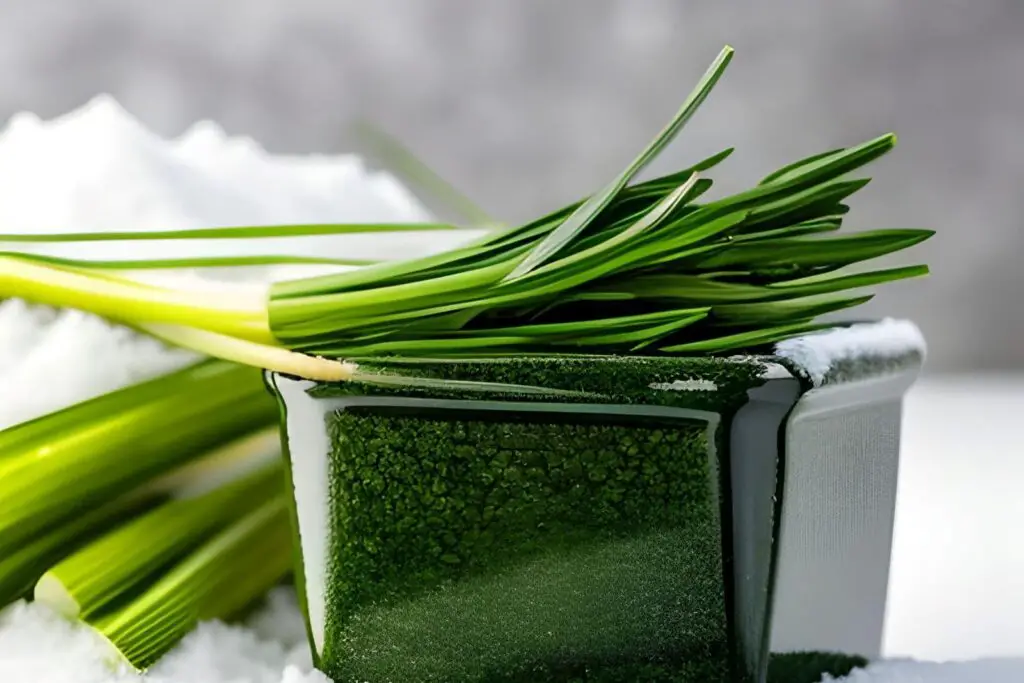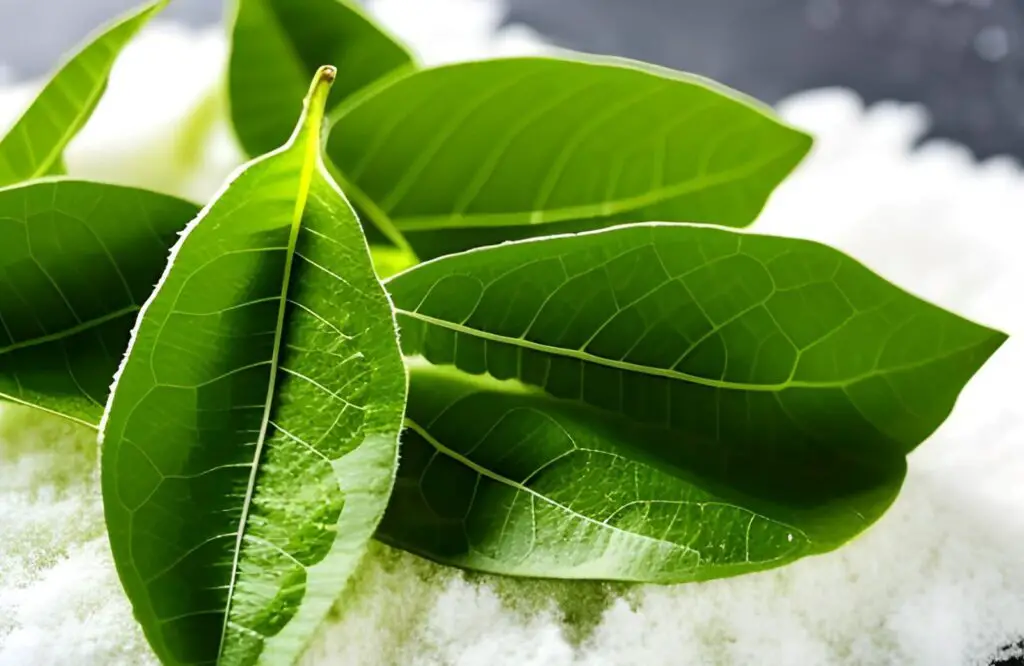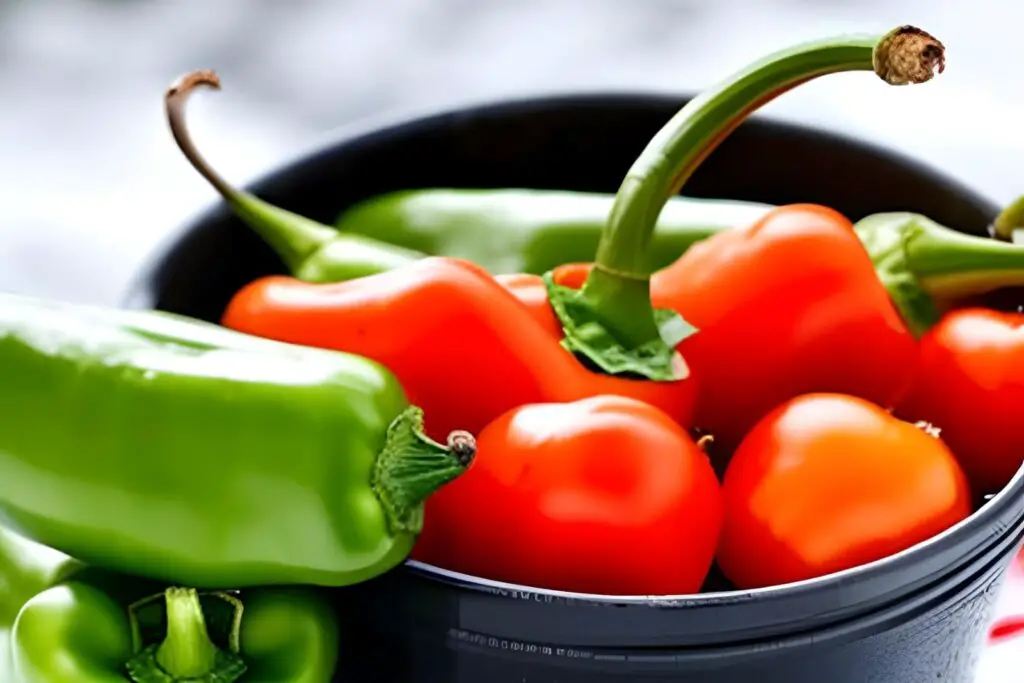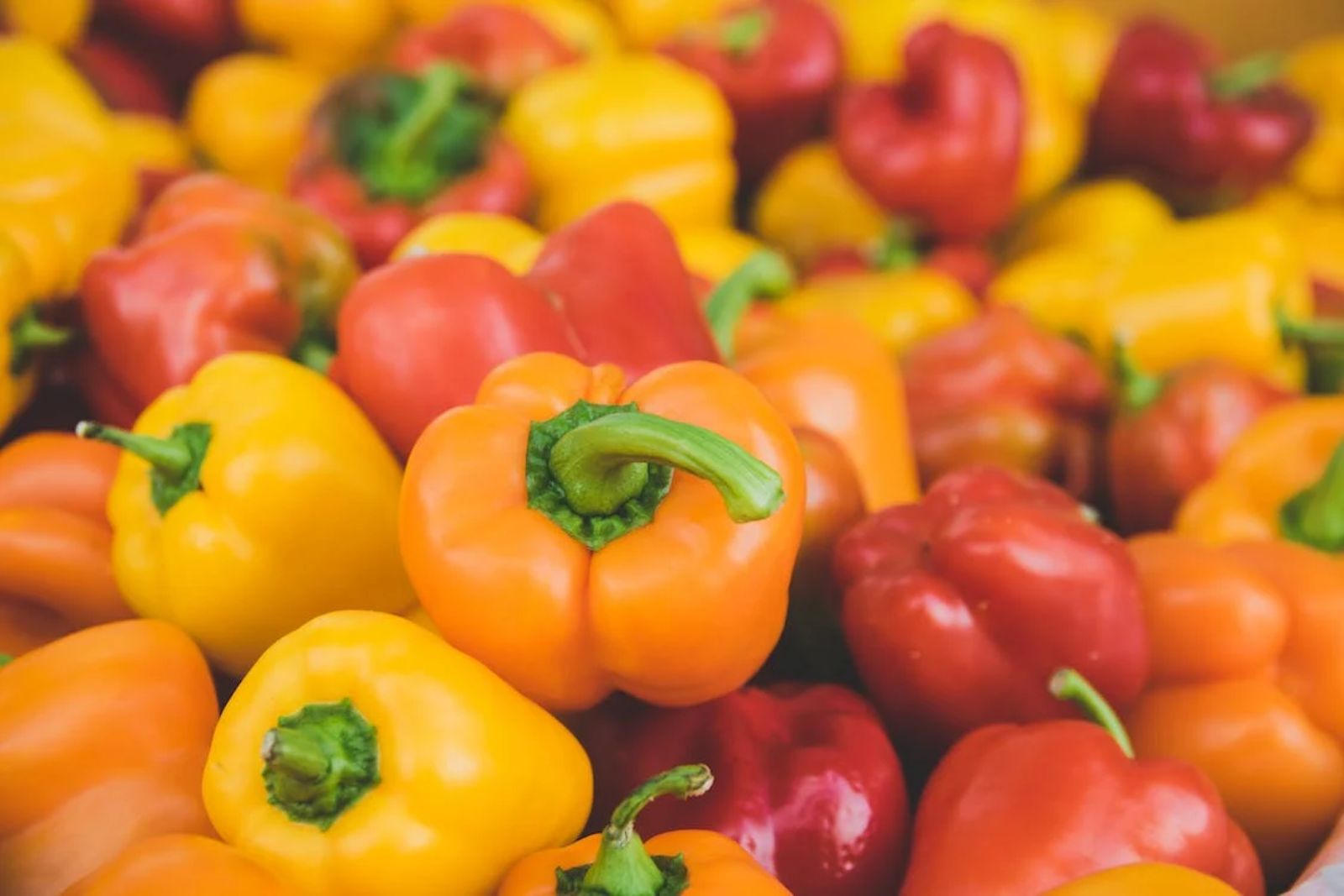
Peppers, also known as bell peppers or sweet peppers, are a type of vegetable that belongs to the Capsicum genus. They are botanically classified as fruits but are commonly considered and used as vegetables in culinary applications. Peppers come in various colors, including green, red, yellow, orange, and even purple. Freezing peppers is a convenient way to preserve their freshness and flavor for future use. Whether you have an abundance of garden-grown peppers or simply want to stock up on your favorite varieties, freezing them properly will help maintain their taste and texture.
Here are the steps to freeze peppers:
Step 1: Choose fresh and ripe peppers
When it comes to freezing peppers, selecting fresh and ripe ones is crucial for maintaining their quality during the freezing process. Here’s why it’s important:
- Freshness: Fresh peppers have a vibrant color, firm texture, and a crisp taste. Freezing them at their peak freshness ensures that they retain their natural flavors and textures when you thaw and use them later.
- Texture: Ripe peppers have a desirable texture, whether it’s the crunchy bite of a bell pepper or the tender flesh of a chili pepper. By starting with fresh and ripe peppers, you can preserve their texture after freezing, ensuring they remain enjoyable to eat.
- Color: Vibrant colors are not only visually appealing but also an indicator of the pepper’s ripeness and flavor. Choosing peppers that are rich in color, such as bright red, deep green, or vibrant yellow, will enhance the overall visual appeal of your frozen peppers.
- Quality: Fresh and ripe peppers are less likely to have blemishes, soft spots, or signs of spoilage. By selecting peppers that are free from any damage or decay, you can ensure that your frozen peppers will maintain their quality and taste when thawed and used in future dishes.
- Variety: Peppers come in various types and flavors, such as bell peppers, jalapenos, and chili peppers. Each variety has its own unique characteristics, spice levels, and uses in cooking. Choose the pepper varieties that align with your taste preferences and intended culinary applications.
Should I freeze unripe peppers?
It is generally not recommended to freeze unripe peppers as they may not have developed their full flavor and sweetness. Unripe peppers tend to have a firmer texture and can become mushy when frozen and thawed. For the best quality and taste, it is advisable to wait until the peppers are fully ripe before freezing them.
Can I freeze bell peppers that have started to wrinkle or soften?
It is not recommended to freeze bell peppers that have already started to wrinkle or soften. Bell peppers that have lost their firmness and developed wrinkles indicate a decline in quality and freshness. Freezing them in this state may result in further deterioration of texture and flavor, leading to a less desirable end product. It is best to use fresh, firm bell peppers for freezing to ensure the highest quality when thawed and cooked.
Step 2: Wash and prepare the peppers
Once you have selected fresh and ripe peppers for freezing, it’s important to wash and prepare them properly. Here’s why this step is essential:
- Removal of dirt and debris: Peppers can accumulate dirt, residue, or pesticides on their surface, even if they appear clean. Washing them under cool running water helps remove any contaminants, ensuring that your frozen peppers are clean and safe to consume.
- Hygiene: Washing the peppers before freezing is a crucial step for maintaining good hygiene in your food preparation. It minimizes the risk of bacterial contamination and promotes food safety.
- Drying: After washing the peppers, pat them dry with a clean kitchen towel. Removing excess moisture is important because it prevents ice crystals from forming during freezing. Ice crystals can affect the texture of the peppers and potentially lead to freezer burn. Drying the peppers also helps them freeze more efficiently and retain their quality when thawed.
- Removing stems, seeds, and membranes: Depending on your personal preference and intended use, you may choose to remove the stems, seeds, and membranes from the peppers. The stems are typically tough and not pleasant to eat, so removing them improves the overall texture of the peppers. Seeds and membranes, particularly in hotter pepper varieties, contain capsaicin, the compound responsible for spiciness. By removing the seeds and membranes, you can reduce the peppers’ heat level if desired.
- Cutting or leaving peppers whole: The choice of slicing, dicing, or leaving the peppers whole depends on how you plan to use them later. Sliced or diced peppers are convenient for adding to stir-fries, soups, or other dishes, while whole peppers can be stuffed or used for roasting. Consider your future culinary needs and preferences when deciding how to prepare the peppers for freezing.
Can I freeze peppers without washing them?
It is not recommended to freeze peppers without washing them. Washing peppers before freezing is important to remove any dirt, debris, or potential contaminants on the surface of the peppers. Additionally, washing helps ensure that the peppers are clean and ready for consumption when you decide to use them after thawing. Properly washing the peppers before freezing contributes to food safety and the overall quality of the frozen peppers.
Can I freeze peppers without removing the seeds?
Yes, you can freeze peppers without removing the seeds, but it’s generally recommended to remove them before freezing. The seeds of peppers contain the highest concentration of capsaicin, the compound responsible for their spiciness. If you prefer a milder flavor, removing the seeds can help reduce the heat. However, if you enjoy the heat, you can freeze the peppers with the seeds intact. Keep in mind that freezing with seeds may result in a slightly spicier taste when using the peppers later.
Step 3: Blanch the peppers
Blanching peppers before freezing is a crucial step that helps maintain their color, texture, and nutritional value. Here’s why blanching is important:
- Color retention: Peppers contain enzymes that can cause them to darken and lose their vibrant color over time. Blanching deactivates these enzymes, preserving the peppers’ natural color and visual appeal. The brief exposure to boiling water helps set the pigments and ensures that the peppers remain visually appealing even after freezing and thawing.
- Texture preservation: Blanching also helps to maintain the crispness and texture of the peppers. The short exposure to boiling water helps to soften the peppers slightly without fully cooking them. This process helps to preserve their crunchiness and prevents them from becoming mushy or limp during freezing and subsequent use.
- Nutritional value: Blanching peppers briefly helps to retain their nutritional value. While some vitamins and nutrients may be lost during the blanching process, it is minimal compared to the potential loss that can occur during prolonged freezing. Blanching helps to lock in the essential nutrients and antioxidants present in the peppers, ensuring that they remain relatively intact for a longer period.
- Blanching process: To blanch the peppers, bring a pot of water to a boil. While the water is heating, prepare a bowl of ice water. Submerge the peppers in the boiling water for about 1 to 2 minutes, depending on their size. The boiling water helps to partially cook the peppers and inactivate the enzymes. After the blanching time, quickly transfer the peppers to the ice water bath. The ice water stops the cooking process immediately and helps cool down the peppers rapidly, preserving their texture and color.
Can I freeze peppers without blanching them?
While blanching is recommended to preserve the color, texture, and nutritional value of peppers, you can skip this step if you prefer. However, keep in mind that the peppers may experience some quality loss in terms of color and texture without blanching.
Step 4: Drain and dry the peppers
Once the peppers have been blanched and cooled in the ice water bath, it’s important to drain and dry them properly. Here’s why this step is crucial:
- Removal of excess moisture: After blanching, the peppers may retain some water on their surface. It’s essential to remove this excess moisture as it can contribute to the formation of ice crystals during freezing. Ice crystals can negatively impact the texture of the peppers and potentially lead to freezer burn. By draining and drying the peppers, you minimize the risk of ice crystal formation and help maintain their overall quality.
- Prevention of clumping: If the peppers are packed with excess moisture, they may stick together when frozen. This can make it challenging to separate and use individual pieces later on. By ensuring the peppers are thoroughly drained and dried, you reduce the likelihood of clumping and facilitate easier handling and portioning when you retrieve them from the freezer.
- Preservation of texture: Excess moisture can affect the texture of the peppers when they freeze. The presence of water molecules can lead to cell rupture and damage, resulting in a mushy or soft texture upon thawing. By removing the excess moisture, you help preserve the crispness and integrity of the peppers, ensuring they retain their desired texture after freezing and thawing.
- Methods for draining and drying: There are two common methods for draining and drying the peppers. You can use a colander to drain the peppers and allow any remaining water to drip off. Alternatively, you can gently pat the peppers dry with a clean kitchen towel, absorbing any moisture on their surface. Ensure that the peppers are adequately dry before proceeding to the next step.
Step 5: Pack and label the peppers
Once the peppers have been drained and dried, it’s important to pack them properly for freezing. Here’s why this step is essential:
- Freezer-safe packaging: To preserve the quality of the peppers during freezing, it’s important to use freezer-safe bags or containers. These are designed to withstand the low temperatures of the freezer and prevent freezer burn. Freezer burn occurs when moisture in the food evaporates, leading to dry and discolored patches. Using the appropriate packaging helps maintain the flavor, texture, and appearance of the peppers.
- Air removal (for bags): If you choose to use freezer bags, it’s important to remove as much air as possible before sealing them. Air can contribute to the formation of ice crystals and deteriorate the quality of the peppers over time. Squeezing out excess air from the bags helps minimize the potential for freezer burn and maintains the peppers’ freshness.
- Headspace (for containers): If you opt for containers, leave some headspace to account for expansion during freezing. As the peppers freeze, they may expand slightly, and having adequate headspace prevents the containers from cracking or bursting. Leaving about an inch of empty space at the top of the container allows for safe freezing without compromising the peppers or the container.
- Labeling: It’s important to label the bags or containers with the date and the type of peppers inside. This information helps you keep track of the peppers’ freshness and variety. By indicating the date, you can easily identify how long the peppers have been frozen, enabling you to use them within their recommended storage time. Knowing the variety of peppers is also helpful when you’re planning your recipes and meals.
Step 6: Freeze the peppers
After properly packing and labeling the peppers, it’s time to freeze them. Follow these steps to ensure optimal freezing and storage:
- Lay flat for even freezing: Place the packed peppers in the freezer, ensuring that they are laid flat. This allows for even freezing and prevents the peppers from sticking together. By keeping them flat, you create a uniform freezing surface and minimize the chances of clumping or uneven texture.
- Avoid stacking initially: It’s important not to stack the bags or containers until the peppers are completely frozen. If they are stacked too early, the peppers may become squished or stick together, making it difficult to separate them later on. Allow the peppers to freeze in a single layer initially.
- Prevent clumping: Freezing the peppers in a single layer initially helps prevent clumping. Once they are completely frozen, you can rearrange and stack them if desired. By taking this precaution, you ensure that the peppers remain individually frozen and easily accessible when you need to use them.
- Organize and maximize space: Once the peppers are fully frozen, you can arrange them in the freezer to maximize space and efficiency. Consider grouping them by variety or by the intended use in your recipes. This organization will make it easier to locate and retrieve the specific peppers you need.
- Explanation: Freezing the peppers promptly after packing them ensures that they maintain their freshness and quality. Laying them flat for initial freezing allows for even distribution of cold air and prevents them from clumping together. Stacking the peppers only after they are completely frozen prevents them from becoming misshapen or fused together. By following these steps, you ensure that the frozen peppers remain individually frozen and easily accessible for future use.
Remember to maintain a consistent freezing temperature in your freezer and avoid frequent fluctuations to preserve the quality of the frozen peppers.
Other related questions
How long can peppers last in the freezer?
Peppers can last in the freezer for approximately 8 to 12 months. The exact duration depends on factors such as the type of peppers, their initial quality, and how well they are stored. Properly sealed and stored peppers can maintain their quality and flavor for an extended period.
How do I defrost peppers?
There are two primary methods to defrost peppers: in the refrigerator or using the cold water method. To defrost in the refrigerator, transfer the frozen peppers from the freezer to a plate or bowl and let them thaw overnight. Alternatively, for a quicker thaw, place the peppers in a sealed plastic bag and submerge them in cold water, changing the water every 30 minutes until they thaw completely. Avoid using hot water as it can partially cook the peppers.
How do I know if the peppers have gone bad after being frozen?
After being frozen, peppers can show signs of spoilage. Look for indicators such as freezer burn, discoloration, excessive ice crystals, or a mushy texture. If the peppers have an off-putting smell or taste, they may have gone bad. It’s important to trust your senses and discard any frozen peppers that exhibit these signs of spoilage to ensure food safety.
Can I refreeze peppers?
It is generally not recommended to refreeze peppers once they have been thawed. Freezing, thawing, and refreezing can negatively impact the quality, texture, and flavor of the peppers. The repeated freeze-thaw cycles can lead to moisture loss, deterioration of the cell structure, and a decrease in overall quality. It is best to use the thawed peppers promptly or store them in the refrigerator for a short period before consumption.
Can I freeze different types of peppers together?
Yes, you can freeze different types of peppers together. Mixing various pepper varieties in a single bag or container is acceptable. Just ensure they are properly washed, prepared, and packed together before freezing.
Can I freeze stuffed peppers?
While it is technically possible to freeze stuffed peppers, the texture of the filling may change during freezing and thawing. It’s recommended to freeze the filling and the peppers separately for better results and assemble them before cooking when you’re ready to use them.
Can I freeze peppers that have already been cooked?
Yes, you can freeze peppers that have already been cooked. However, the texture of the peppers may change during freezing and thawing, resulting in a softer or slightly mushy consistency. It’s best to slightly undercook the peppers if you plan to freeze them, as they will continue to cook slightly during the reheating process. Consider using cooked frozen peppers in recipes such as soups, stews, or sauces, where the texture change is less noticeable.
Can I freeze roasted peppers?
Yes, you can freeze roasted peppers. Roasting peppers before freezing enhances their flavor and allows for easy removal of the skin. After roasting, let the peppers cool, remove the skin, seeds, and membranes if desired, then pack them in airtight containers or freezer bags. Frozen roasted peppers can be used in various recipes such as sandwiches, salads, pasta dishes, or as a flavorful addition to sauces and dips.
Are there any special considerations for freezing hot peppers?
When freezing hot peppers, there are a few special considerations to keep in mind. First, it’s essential to wear gloves while handling hot peppers to protect your skin and prevent irritation or burns. Additionally, be cautious of the volatile oils present in hot peppers, as they can cause discomfort or even respiratory irritation when inhaled. Lastly, consider labeling the frozen hot peppers clearly to avoid confusion and accidental consumption, as they can retain their heat even after being frozen.
Are there any specific types of peppers that freeze better than others?
When it comes to freezing peppers, some varieties tend to freeze better than others. Generally, thick-fleshed peppers like bell peppers and poblano peppers freeze well due to their sturdy structure. These peppers maintain their texture and flavor after freezing and thawing. On the other hand, thin-walled peppers, such as chili peppers or banana peppers, may become softer or mushy when frozen but can still be used in cooked dishes where texture is less critical.

